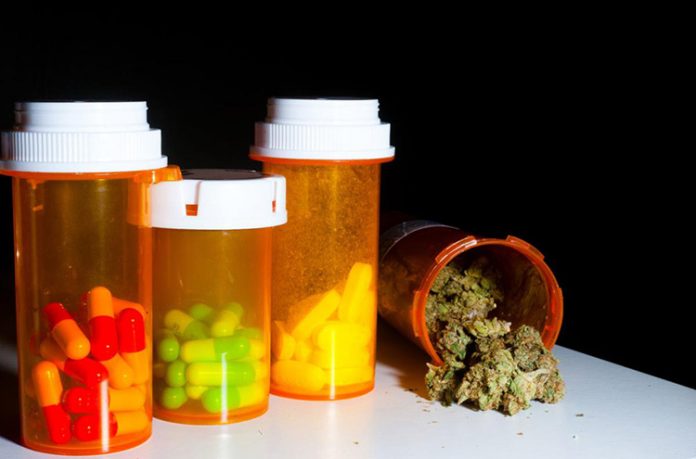Some states allowing medical marijuana and recreational pot saw declines in opioid prescribing as authorities pushed urgent efforts to combat the historic American drug crisis.
Medicaid patients, for example, are getting about 5.9 percent fewer prescription painkillers in medical marijuana states. Further, the opioid prescription declines are deeper where recreational pot is allowed, down nearly 6.4 percent, according to the Albany-based Rockefeller Institute of Government.
“Policymakers and activists are grappling with how to best address the problem, but are often stymied by budget constraints and a lack of evidence as to what actually works,” said report author Heather Trela, referring to opioid addiction.
“Recent research, however, has found that legal access to marijuana may be a potential tool for addressing the opioid crisis,” she said.
Trela blamed the lack of evidence on federal laws that treat marijuana the same as heroin and other dangerous narcotics, which limits research.
But some lawmakers, including New York’s Democratic Senator Charles Schumer, have recently pushed legislation to decriminalize marijuana across the country and build upon studies underway.
One high-profile National Institutes of Health study was awarded recently to researchers at Albert Einstein College of Medicine and Montefiore Health System in the Bronx.
The five-year, $3.8 million grant is for the first long-term study to test whether medical marijuana reduces opioid use among adults with chronic pain, including those with HIV, the health system said.
Against that backdrop, the Rockefeller Institute report detailed a range of studies from medical journals and universities. They include:
• Overall, patients in medical marijuana states filled fewer daily doses of opioids, University of Georgia research found. For example, they saw a 14.4 percent reduction by Medicare patients in states with access to a medical marijuana dispensary.
• In more restrictive states that only permitted home cultivation of medical marijuana, however, there was just a 6.9 percent reduction in opioid use among Medicare patients.
• Marijuana reforms have also saved taxpayers’ money, according to recent JAMA Internal Medicine studies.
• Recreational marijuana laws were tied to 9.78 percent lower Medicaid spending on prescription opioids, an annual savings of $1,815 Medicaid spending per 1,000 enrollees, the study found.
Trela noted some research found a link between states that have medical marijuana dispensaries and a decrease in opioid mortality rates, citing a study in the Journal of Health Economics.
A 2016 article in The Journal of Pain asserted patients that had chronic pain and used medical marijuana were 64 percent less likely to report the use of opioids, Trela said.
Negative findings
It is important to note, however, that not all recent research findings have been positive, she said, citing how The American Journal of Psychiatry reported that marijuana use actually increases the risk of an opioid-use disorder.
The marijuana research push comes after high-profile political battles over state marijuana reform across the country, such as a billboard campaign in Indiana last year, USA TODAY Network reported.
Drivers heading east towards Indianapolis on I-70 encountered the billboard promoting marijuana as the solution to the opioid epidemic.
“States with Medical Cannabis have 25% fewer opioid overdose deaths,” the sign stated.
Indiana NORML, a marijuana advocacy group in the state, paid for the billboard amid that state’s debate over allowing medical marijuana. The group cited the opioid statistic from a 2014 study published in the Journal of the American Medical Association.
In New York, doctors promoting medical marijuana as a solution to the opioid crisis have spoken out about patients demanding improved access to cannabis-based medicine, USA TODAY Network reported.
‘Blow your mind’
Patricia Kendall, a family nurse practitioner in Brockport, started her own practice and registered to offer medical marijuana after working for years with people in chronic pain.
“The amount of opioids they’re on, it would blow your mind,” she said. “It bothered me. These patients knew they were on a lot of medications. They didn’t have alternatives when I was working with them.”
Kendall said people who’ve called have not expressly asked to get off opioids, but she expects those questions.
“Some patients are not aware there is a better alternative than opioids that the provider is offering them,” she said.
The researchers found that the implementation of state medical and recreational marijuana laws was associated with a lower prescription rate of Medicaid-covered opioids — a 5.88 percent lower rate of Medicaid-covered opioids in states that had implemented medical marijuana legislation and an additional 6.38 percent lower opioid prescription rate in states that also implemented recreational marijuana use.
Recreational marijuana laws also were found to be associated with 9.78 percent lower Medicaid spending on prescription opioids, an annual savings of $1,815 Medicaid spending per 1,000 enrollees.














